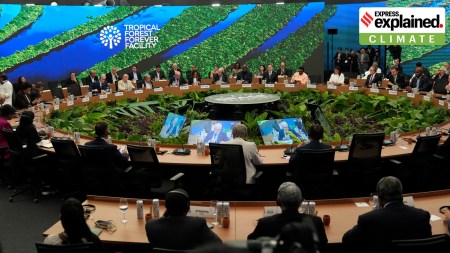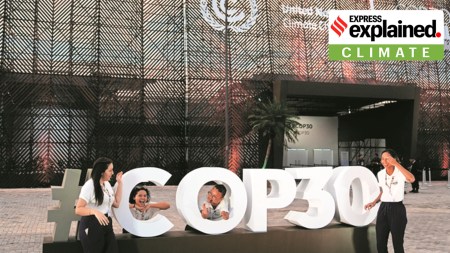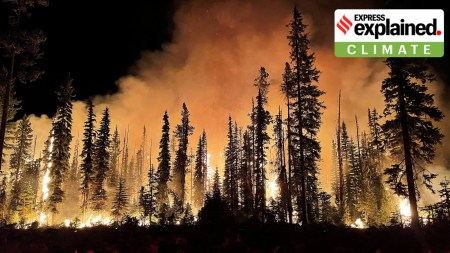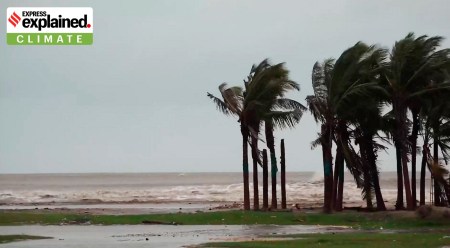EXPLAINED CLIMATE NEWS
How clean energy could save the world trillions
As clean energy prices fall, a fast transition to renewable energy is the cheapest option on the table.
In 2025, Earth’s oceans were warmer than ever: What does it mean for the planet?
Almost 90% of the extra heat trapped by greenhouse gases (GHGs) has been absorbed by the oceans, making them steadily warmer over the decades
US exit from several climate bodies can mean both relief, challenges for India: Here’s whySubscriber Only
By disassociating completely from the international climate regime, the US might be jeopardising its own long-term interests. Here's how
US leaves India-headquartered International Solar Alliance after Trump order: What to know
The International Solar Alliance (ISA) is the only India-headquartered organisation among the 60-plus institutions that the United States has now exited.
Yearender | Climate: A shift in the climate narrative as Paris pact comes under scrutiny
With the Paris Agreement completing 10 years in November 2025, countries have questioned many of its principles. The US has exited the pact, and other countries are looking to pursue their own pathways to combat climate .
Global South taking the brunt of climate disasters: How extreme weather events impacted the world in 2025Subscriber Only
While the United States witnessed the most expensive climate disaster of this year, Asia accounted for four of the six costliest extreme weather events of 2025, according to a new report
2025 is ‘year of blooming octopus’ in England: Behind rising numbers of world’s most intelligent invertebratesSubscriber Only
Octopuses possess great problem-solving skills (such as opening jars and untying knots), and are champions of camouflaging. However, their growing numbers could impact the marine ecosystem.
Why dense fog is lingering over Punjab, Haryana and Chandigarh for so long, even during the daySubscriber Only
Certain weather conditions, along with pollution, are behind the prevailing fog in Punjab and Haryana. Here's why the fog isn't lifting.
Crown under threat: How unseasonal rainfall is affecting India’s mangoes, the king of fruitsSubscriber Only
Mangoes are a crucial part of India’s agricultural economy, as the country is the largest producer of the fruit in the world. However, the country's mango productivity has remained stagnant between 2018-2019 and 2023-2024
3 factors that made Cyclones Ditwah & Senyar so deadlySubscriber Only
A new study has said that although the affected countries experience annual floods during the monsoon season, this year, the proportions of the flood reached unprecedented levels.
Explained: Lessons from Beijing in clearing Delhi’s air pollutionSubscriber Only
Beijing drastically reduced air pollution levels in around a decade. Behind its success is a comprehensive policy framework that can be replicated
Africa’s forests transformed from carbon sink to carbon source: Why does it matter?Subscriber Only
The development means that the world’s three major rainforest regions — South American Amazon, Southeast Asia, and Africa — are now adding carbon into the atmosphere, exacerbating global warming
How China dealt with air pollution, lessons for IndiaSubscriber Only
China has made strides in reducing the level of certain pollutants in major cities in just a few years. Can India learn from its experience?
US in fight against climate change: Never a leader, but still significantSubscriber Only
As the world’s largest historical emitter of greenhouse gases, and also the country with great financial, scientific and technological capability, the United States has both the responsibility and the capability to take the lead in the fight against climate change.
Why Vadodara was colder than Naliya in the Thar desert: Local conditions, wind pattern, cloudsSubscriber Only
Vadodara recorded 14 degrees C on November 8 and Naliya in Thar desert area, usually the coldest place in Gujarat, 15.4 degrees C
New fund to protect world’s tropical forests: What is the TFFF, and what are the concerns about it?Subscriber Only
Speaking at the fund’s launch event on November 6, Brazil’s President Luiz Inácio Lula da Silva described the TFFF as 'an unprecedented initiative'. He also said that 'for the first time, Global South countries will have protagonism in the forest agenda'
COP30 begins today in Brazil: Limited outcomes so far, focus on implementationSubscriber Only
It’s now been more than 30 years that countries have been getting together to deliberate on a coordinated global response to climate change.
‘Climate change is driven by human need and human greed’: Yale historian Sunil Amrith on his book and all things climate changeSubscriber Only
Environmental historian Sunil Amrith spoke to Kaushik Das Gupta about his book The Burning Earth, climate change, and why technological fixes are inadequate in the face of the crisis
Why Bill Gates’ changed climate views are in step with India’sSubscriber Only
Limiting emissions and temperature rise is one way of managing the climate change crisis. Gates has argued for adaptation and building resilience, which has immediate benefits for developing countries.
Wettest November in six years in Mumbai: What led to the unseasonal showersSubscriber Only
The wet start to the month is indicative of more showers on the cards for the region. While no warnings have been sounded, the IMD — in its forecast bulletin — has indicated that light to moderate showers will continue in Mumbai as well as Thane, Palghar and Raigad until at least November 6
Delhi air pollution: Why cloud seeding in winter has a specially low chance of success, according to scienceSubscriber Only
We must thank nature that the Delhi drizzle, if it indeed resulted from seeding, did not coincide with cooler temperatures. Substantial rainfall is required to wash out particulates; light drizzles under cooler conditions often do the opposite.
Rise in oil & gas production, inadequate climate finance: How the Global North is derailing climate goalsSubscriber Only
The latest analysis, carried out by the advocacy organisation Oil Change International, has revealed that Australia, Canada, Norway, and the US have collectively increased their oil and gas production by 14 million barrels of oil equivalent per day (boe/d) between 2015 and 2024
Explained: How cloud seeding works, and the idea behind combating air pollution with itSubscriber Only
What conditions are needed for cloud seeding, and why have earlier proposals for it come under criticism? We explain.
Cyclone Montha landfall: What exactly is a ‘landfall’, how much damage can it cause?Subscriber Only
Cyclone Montha landfall, Andhra Pradesh Cyclone Montha updates: Cyclone Montha is expected to make landfall on Tuesday night between Kakinada and Machilipatnam. Around 10,000 people have been moved to hundreds of relief camps set up in schools and government offices
Cyclone Montha likely to hit east coast: How do tropical storms occur, and who names them?Subscriber Only
Cyclone Montha alert, impact: Here is what to know about how tropical storms are formed, why the Bay of Bengal witnesses them frequently, and why this storm has been named Cyclone Montha.
BEST OF EXPRESS



Must Read

















































